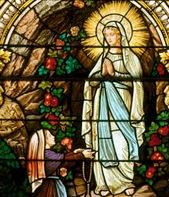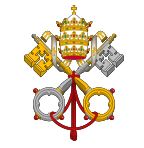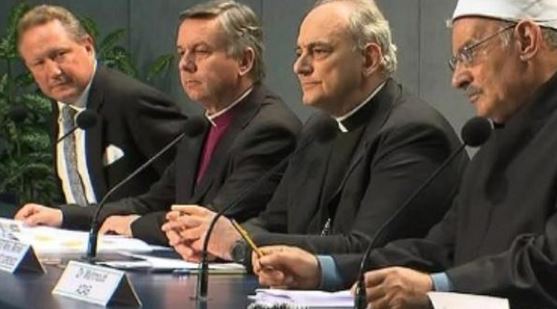
The Miracle Business
 It is the time of year to turn away from expensive bottles of Grange, from the slings and arrows of outrageous elections, the whips and scorns of recursive fury, the tricks of telediagnosis, the Tower of Psychobabblica, the barbarians at the gate, the follies of climate alarmism, et cetera, and reflect on the business of miracles, a joint canonisation, and a local candidate for sainthood.
It is the time of year to turn away from expensive bottles of Grange, from the slings and arrows of outrageous elections, the whips and scorns of recursive fury, the tricks of telediagnosis, the Tower of Psychobabblica, the barbarians at the gate, the follies of climate alarmism, et cetera, and reflect on the business of miracles, a joint canonisation, and a local candidate for sainthood.
Miracle, n.,1. Latin miraculum, from mirari, “to wonder”. 2. A mysterious or inexplicable event attributed to a supernatural or divine power. 3. A statistically unlikely event not contrary to natural law, such as surviving an illness, or winning a lottery. 4. See prayer, n., the act of asking the laws of the universe to be annulled on behalf of one or more petitioners, confessedly unworthy — Ambrose Bierce, “The Devil’s Dictionary“.
But what qualifies as a miracle in a world where Genesis is a fitness club, Revelations a fashion show and the Lorde a teenager whose debut album was Pure Heroine? US bus driver, Rickey Wagoner, 49, believes he is alive because of one. According to stunned police, the Bible he kept in his pocket stopped two bullets that would have killed him. ‘There was obviously some kind of intervention involved because he probably should not be here,’ said Sergeant Michael Pauley of the Dayton, Ohio police. After the attempted robbery, Wagoner picked up a gun dropped by one the fleeing assailants and fired at them. The God (or Goddess) of Mercy intervened again. He missed them.
The Almighty seems fond of football too. How else to explain why the Miracle of Berne is more revered in Germany today than the Miracle of Lourdes, even though the Das Wunder von Bern happened at a World Cup sixty years ago?
The Bible is full of them. They are the core business of many Catholic rites and rituals. But how does the Church ensure an alleged miracle is the real deal? An elaborate system of quality-control protocols have been developed over the centuries to protect the integrity of its imprimatur. The Vatican Congregation for the Causes of Saints (Congregatio de Causis Sanctorum) manages the four-stage (servant of God/venerable/blessed/saint) process – from declaration of “heroic virtues” to beatification – that almost always culminates in canonization.
Every case includes a best-practice assessment of miracle quality. Three degrees of miracle are recognised in this context: (i) quoad substantiam – where a dead person is resurrected; (ii) quoad subiectum – where an incurably sick person completely recovers, with reconstitution of damaged organs (restitutio in integrum); (iii) quoad modum: where there is instantaneous recovery from an illness that treatment could have achieved only after a long period.
The Pope ultimately decides who proceeds to beatification or canonization, thanks to Urban VIII’s Bull of 1634 giving the Holy See this exclusive right, apparently as a way of preventing “fraud by the Evil One.” On September 30 last year, Pope Francis decreed that blesseds John XXIII and John Paul II would be “enrolled among the saints on April 27, 2014, the Second Sunday of Easter, of the Divine Mercy.” The Holy Father’s decision was announced in the Consistory Hall of the Vatican Apostolic Palace at 10am, during mid-morning prayer. A million pilgrims filled St. Peter’s Square for John Paul II’s beatification on May 1, 2011, so even more are expected on April 27 to witness the joint canonisation.
Blessed John Paul II established the Divine Mercy Sunday feast in 2000 to honour Polish nun St. Faustina Kowalska (1905-1938). During her visions of — and conversations with – Jesus, he asked specifically for such an event. Momentously, John Paul II – the second longest-serving pope in history — died on the very eve of Divine Mercy Sunday in 2005. Opening his beatification rite, the vicar of Rome, Cardinal Agostino Vallini, said John Paul II’s motto – Totus tuus (Totally yours) — reflected complete confidence in Mary and “the secret of looking at the world through the eyes of the Mother of God.”
To become a saint a candidate generally needs to have two miracles attributed to his intercession. The second must occur after beatification. A French nun inexplicably cured of Parkinson’s disease led to John Paul II’s 2011 beatification. The second miracle involved a Costa Rican woman apparently cured of a cerebral aneurysm on the “very day” of celebrating it.
Blessed John XXIII, born Angelo Giuseppe Roncalli, was pope from 1958 to 1963 and convened the Second Vatican Council. In his case, Pope Francis took “the rare step of waiving the requirement of a second miracle, paving the way for imminent canonization”.
A striking aspect of today’s miracle business is its appropriation of scientific concepts and the semantics of rationality to “prove” their existence. According to the Catholic Encyclopedia:
A miracle, like any natural event, is known either from personal observation or from the testimony of others….The miraculous character of the fact consists in this: that its nature and the surrounding circumstances are of such a kind that we are forced to admit natural forces alone could not have produced it, and the only rational explanation is to be had in the interference of Divine agency. The perception of its miraculous character is a rational act of the mind, and is simply the application of the principle of causality with the methods of induction. The general rules governing the acceptance of testimony apply to miracles as to other facts of history. . If we have certain evidence for the fact, we are bound to accept it. The evidence for miracles, as for historical facts in general, depends on the knowledge and veracity of the narrators, i.e., they who testify to the occurrence of the events must know what they tell and tell the truth.
The Church also recognises other types of miracles. On July 22 2013, two months before the Holy Father’s above announcement, the Marian Shrine at Lourdes in southern France received an official declaration from the Bishop of Pavia, Italy, stating that “the 69th miracle had taken place there.”
Given the mass-popularity of Lourdes for over a century, it is surprising that only about 7,000 cases of reported miracles have been investigated since the Marian apparitions appeared to Bernadette Soubirous. Of those, only 69 have received the official approval of a bishop, with the majority of cases domiciled in France.
The latest (official) miracle happened on May 4, 1989, after a Mrs. Danila Castelli visited the baths in Lourdes. Mrs Castelli advised the Lourdes Bureau des Constatations Médicales, the body established in 1882 to examine such claims. A 23-year investigation concluded on June 20 last year, when Bishop Giovanni Guidici declared her healing was indeed “prodigious-miraculous” in character. “I have the joy of reporting to everyone my healing,” she said, “which was approved just a few days ago as a miracle by my bishop, which is a beautiful thing.”
In an interview posted on the Lourdes You Tube channel on July 18 last year, Mrs Castelli thanked
“Our Lady for all of the joy I’ve received, not just the joy of a healed body – which is also important because health is a gift of God and we have to protect it and ask for it, life is a gift – but the joy that Our Lord has given me throughout my entire life for as long as I can remember.”
An anonymous official from the Vatican Congregation for the Causes of Saints explained the process to the Catholic News Agency last July 22.
“When a miracle is recognized by the Medical Bureau of the Sanctuary of Lourdes, the paperwork is sent back to the diocese of origin. When recognized by the local bishop, it is recognized officially by the Church as a miracle through the intercession of Our Lady.”
 Before declaring the event miraculous, the Lourdes Bureau met five times between 1989 and 2010. At its final meeting, more than 100 doctors and nurses –with one abstention– approved the cure as miraculous after a “lengthy and very passionate” discussion. Bureau director, Doctor Alessandro de Franciscis, was emphatic: “This lady was judged, indeed certified cured in a way unexplained by current medical scientific knowledge.”
Before declaring the event miraculous, the Lourdes Bureau met five times between 1989 and 2010. At its final meeting, more than 100 doctors and nurses –with one abstention– approved the cure as miraculous after a “lengthy and very passionate” discussion. Bureau director, Doctor Alessandro de Franciscis, was emphatic: “This lady was judged, indeed certified cured in a way unexplained by current medical scientific knowledge.”
But what exactly happened in the grotto of Massabielle near Lourdes in 1858? According to legend, the Blessed Virgin Mary appeared 18 times to a 14 year-miller’s daughter, between February 11 and July 16. She apparently identified herself as The Immaculate Conception and gave Bernadette Soubirous this message on Her 8th appearance on February 24, in the presence of a crowd of 250: “Penance! Penance! Penance! Pray to God for sinners. Kiss the ground as an act of penance for sinners!”
The Church investigated the claims for four years before approving devotion to Our Lady of Lourdes. As for French Catholics, they were already convinced there had been a miraculous event.
There are intriguing issues here, at least according to this account. Bernadette had been gathering firewood at the grotto on February 11 – with her sister and a friend – when she reportedly had a “vision” of “a small young lady” (uo petito damizelo) standing in a niche in the rock. Her companions, however, said they saw nothing. Neither did – or has – anyone else.
It was not until the 17th “vision” that the apparition identified herself (solely) to Bernadette – coincidentally after a request from her “Monsieur le Curé”, Father Peyramale, that it do so. Townspeople who believed she was telling the truth assumed it was the Virgin Mary. Yet
Bernadette never claimed it to be Mary, calling what she saw simply “Aquerò” (or rather “that thing”), aquerò (pronounced [aˈk(e)ɾɔ]) being Gascon Occitan for that. She described the lady as wearing a white veil and a blue girdle; she had a golden rose on each foot and held a rosary of pearls… Bernadette received no further apparitions after the 18th and did not feel any desire to visit the Grotto afterwards, but the people kept on visiting.
For sceptics, Marian apparitions are psychic experiences arising from superstition, susceptibility and poverty, or deliberate hoaxes to attract attention – and pilgrim business. In the Lourdes case, the concept of the “revenant” – a soul returning from purgatory – was deeply rooted in Pyrenean superstition, but not part of Catholic doctrine. Young children apparently “saw” them frequently. Was this why Bernadette’s mother initially forbade her to return to the grotto?
In Ruth Harris’ book, Lourdes: Body and Spirit in the Secular Age, the author noted Bernadette’s description of the apparition as uo petito damizelo (“a tiny maiden”) of about twelve years old. She insisted it was no taller than her 1.40 metres, and “Bernadette was diminutive even by the standards of other poorly nourished children.”
Yet the Our Lady of Lourdes statue in the grotto today – created by Lyonnais sculptor Joseph-Hugues Fabisch in 1864 – depicts an older and taller figure. Bernadette, apparently, was profoundly disappointed on seeing it. As for the apparition’s dress, it was also the uniform of a local religious group called the Children of Mary. Bernadette’s aunt Bernarde was a member. Ironically, she had been refused entry because she was poor – before the grotto visions.
Sceptics also question the authenticity of some early saints, such as the controversial Saint Juan Diego Cuauhtlatoatzin (“eagle that talks”) (1474–1548). Assuming he existed, he was the first Catholic Aztec-American saint. His alleged Marian apparitions near Mexico City in December 1531 inspired the cult of Our Lady of Guadalupe. (What the Blessed Virgin was doing while Hernando Cortez destroyed the Aztec empire between 1519 and 1521 is unclear, at least to non-Catholics.)
Closer to home, WA billionaire Andrew Forrest also believes in miracles, as do some of the folk who invested in his iron ore company a decade ago. The Miracle of Minderoo – aka Forrest’s Kawasaki Moment – was revealed publicly in a speech he gave to the WA Pastoralists & Graziers Association in September 2012: “One of the reasons I became a Christian.” Forrest “found God” in sand hills on his family’s Pilbara sheep station as a nine-year-old. While riding his trail-bike one afternoon some distance from Minderoo homestead, on a whim he threw the bike’s keys over his shoulder to see if he could find them. According to Andrew Burrell, his (unauthorised) biographer:
“…as he now relates the story, he couldn’t find the keys despite several hours of frantic searching and was preparing to brave the elements as sunset approached. As a last resort, he decided to pray. Miraculously, they turned up right in front of his eyes.”
He saw them “between a little petrol overflow and the bike’s carburettor” when he finished praying. “Now there’s not a snowflake’s chance in hell that I threw them there; I threw them over my shoulder. So I just thought okay, that’s cool, we’re showing off a little here, God. That’s a very obvious sign, I won’t ever test you again – and I haven’t.”
 The Almighty works in many strange ways, so it would be presumptuous to claim knowledge of His Purpose. But Forrest’s Kawasaki Moment may have a deeper significance: an early sign of intercession by Saint Peter at the beginning of his spiritual journey from spinifex to spire. While in the Vatican last month, perhaps he noticed the coat of arms of the Holy See and Vatican City State include an image of crossed keys, keys of the office of Saint Peter and the Kingdom of Heaven.
The Almighty works in many strange ways, so it would be presumptuous to claim knowledge of His Purpose. But Forrest’s Kawasaki Moment may have a deeper significance: an early sign of intercession by Saint Peter at the beginning of his spiritual journey from spinifex to spire. While in the Vatican last month, perhaps he noticed the coat of arms of the Holy See and Vatican City State include an image of crossed keys, keys of the office of Saint Peter and the Kingdom of Heaven.
On March 17, the Official Vatican Network announced that “representatives of the Catholic, Anglican and Muslim worlds had gathered “for the first time ever” in the Vatican press office to launch Forrest’s Global Freedom Network, aimed at eradicating human trafficking by the end of the decade.
The agreement was signed [picture below] by Bishop Marcelo Sanchez Sorondo on behalf of Pope Francis, New Zealand Archbishop David Moxon, representing the Archbishop of Canterbury to the Holy See, Dr Mahmoud Azab, representing Cairo’s Grand Imam of Al-Azhar, one of the most important centres of Sunni Islam — and Forrest.
In the Gospel of Matthew 16:19, Jesus says to Peter, “I will give you the keys of the kingdom of heaven, and whatever you bind on earth shall be bound in heaven, and whatever you loose on earth shall be loosed in heaven.” In this case, the phrase “loosed on earth” could refer to the millions of tonnes of high-grade Proterozoic iron ore Forrest is excavating from the Pilbara; and “loosed in heaven” to the philanthropic ventures he is funding out of his loose change.
Whatever the case, Our Man of Minderoo’s prodigious generosity surely moves him ever closer to becoming at least an official Servant of God. According to one anonymous source, nihil obstat (if nothing stands in the way), there is more than a snowflake’s chance in Hell he could become Australia’s second saint one day – after St Mary of the Cross MacKillop.
Madam: Archbishop Fisher (July-August 2024) does not resist the attacks on his church by the political, social or scientific atheists and those who insist on not being told what to do.
Aug 29 2024
6 mins
To claim Aborigines have the world's oldest continuous culture is to misunderstand the meaning of culture, which continuously changes over time and location. For a culture not to change over time would be a reproach and certainly not a cause for celebration, for it would indicate that there had been no capacity to adapt. Clearly this has not been the case
Aug 20 2024
23 mins
A friend and longtime supporter of Quadrant, Clive James sent us a poem in 2010, which we published in our December issue. Like the Taronga Park Aquarium he recalls in its 'mocked-up sandstone cave' it's not to be forgotten
Aug 16 2024
2 mins








